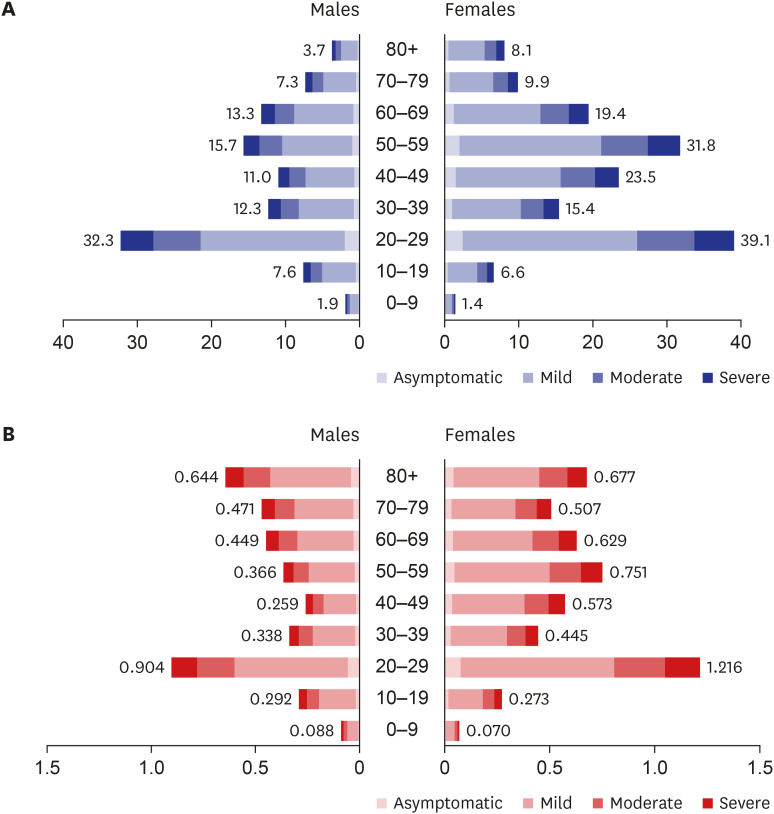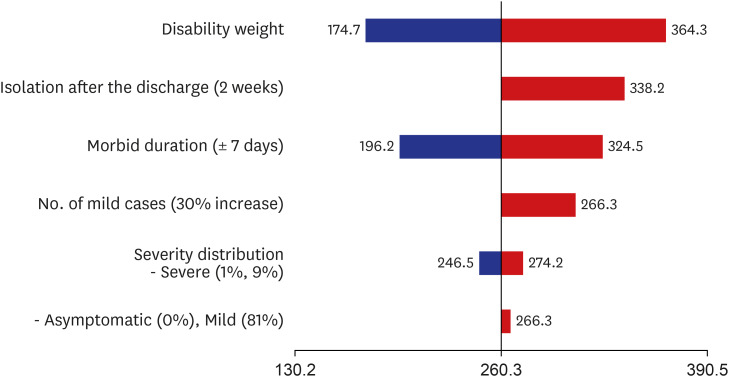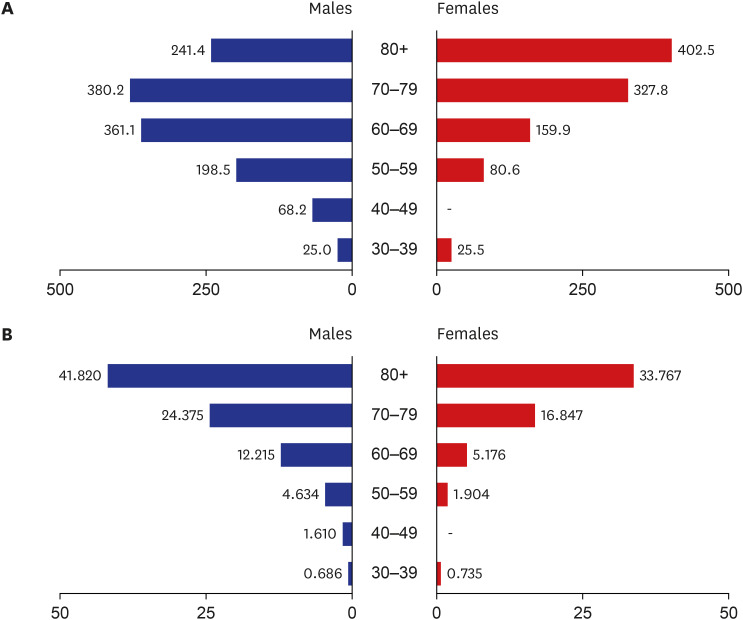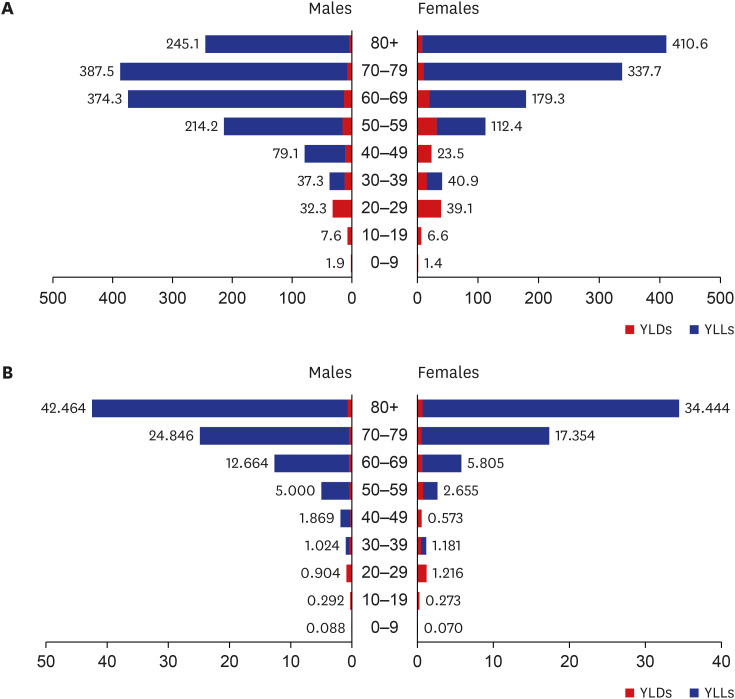J Korean Med Sci.
2020 Jun;35(21):e199. 10.3346/jkms.2020.35.e199.
The Burden of Disease due to COVID-19 in Korea Using Disability-Adjusted Life Years
- Affiliations
-
- 1Department of Preventive Medicine, University of Ulsan College of Medicine, Seoul, Korea
- 2Department of Preventive Medicine, Korea University College of Medicine, Seoul, Korea
- 3Department of Preventive Medicine, Ulsan University Hospital, University of Ulsan College of Medicine, Ulsan, Korea
- 4Department of Preventive Medicine, School of Medicine, Kyung Hee University, Seoul, Korea
- 5Department of Preventive Medicine, Ewha Womans University School of Medicine, Seoul, Korea
- KMID: 2502245
- DOI: http://doi.org/10.3346/jkms.2020.35.e199
Abstract
- Background
The world is currently experiencing a pandemic of coronavirus disease 2019 (COVID-19). In Korea, as in other countries, the number of confirmed cases and deaths due to COVID-19 have been rising. This study aimed to calculate the burden of disease due to COVID-19 in Korea.
Methods
We used data on confirmed cases and deaths due to COVID-19 between January 20 and April 24, 2020 provided by the Korea Centers for Disease Control and Prevention, the local governments and the public media to determine disability-adjusted life years (DALYs) by sex and age. Morbidity was estimated directly among the confirmed, cured, and fatal cases. Disability weights were adopted from previous similar causes on the severity of COVID-19 for the years of life lived with disability (YLDs). The years of life lost (YLLs) were calculated using the standard life expectancy from the 2018 life tables for each sex and age.
Results
The YLDs were higher in females (155.2) than in males (105.1), but the YLLs were higher in males (1,274.3) than in females (996.4). The total disease burden attributable to COVID-19 in Korea during the study period, was estimated to be 2,531.0 DALYs, and 4.930 DALYs per 100,000 population. The YLDs and the YLLs constituted 10.3% and 89.7% of the total DALYs, respectively. The DALYs per 100,000 population were highest in people aged ≥ 80 years, followed by those aged 70–79, 60–69, and 50–59 years, but the incidence was the highest in individuals aged 20–29 years.
Conclusion
This study provided the estimates of DALYs due to COVID-19 in Korea. Most of the disease burden from COVID-19 was derived from YLL; this indicates that decision-makers should focus and make an effort on reducing fatality for preparing the second wave of COVID-19.
Keyword
Figure
Reference
-
1. Wu Z, McGoogan JM. Characteristics of and important lessons from the coronavirus disease 2019 (COVID-19) outbreak in China: summary of a report of 72 314 cases from the Chinese Center for Disease Control and Prevention. JAMA. 2020; 323(13):1239–1242.2. Central Disaster and Safety Countermeasures Headquarters. COVID-19 regular briefing, 2020. Updated 2020. Accessed May 11, 2020. http://www.mohw.go.kr/react/al/sal0301vw.jsp?PAR_MENU_ID=04&MENU_ID=0403&page=15&CONT_SEQ=353265.3. Korea Centers for Disease Control and Prevention. Cases of COVID-19 in Korea. Updated 2020. Accessed May 11, 2020. http://ncov.mohw.go.kr/bdBoardList_Real.do?brdId=1&brdGubun=11&ncvContSeq=&contSeq=&board_id=&gubun=.4. Yoon J, Yoon SJ. Quantifying burden of disease to measure population health in Korea. J Korean Med Sci. 2016; 31(Suppl 2):S101–7. PMID: 27775246.
Article5. Lopez AD, Mathers CD, Ezzati M, Jamison DT, Murray CJ. Global burden of disease and risk factors. The World Bank;2006.6. Yoon SJ, Go DS, Park H, Jo MW, Oh IH, Kim YE. The Korean national burden of disease study: from evidence to policy. J Korean Med Sci. 2018; 34(Suppl 1):e89. PMID: 30923492.
Article7. Song JY, Yun JG, Noh JY, Cheong HJ, Kim WJ. COVID-19 in South Korea - challenges of subclinical manifestations. N Engl J Med. 2020; 382(19):1858–1859. PMID: 32251568.
Article8. Ock M, Lee JY, Oh IH, Park H, Yoon SJ, Jo MW. Disability weights measurement for 228 causes of disease in the Korean burden of disease study 2012. J Korean Med Sci. 2016; 31(Suppl 2):S129–38. PMID: 27775250.
Article9. Statistics Korea. Life table. Updated 2020. Accessed April 8, 2020. http://kosis.kr/statHtml/statHtml.do?orgId=101&tblId=DT_1B42&conn_path=I3.10. Statistics Korea. Population Statistics based on resident registration. Updated 2020. Accessed April 8, 2020. http://kosis.kr/statHtml/statHtml.do?orgId=101&tblId=DT_1B040M1&conn_path=I3.11. Kim YE, Park H, Jo MW, Oh IH, Go DS, Jung J, et al. Trends and patterns of burden of disease and injuries in Korea using disability-adjusted life years. J Korean Med Sci. 2019; 34(Suppl 1):e75. PMID: 30923488.
Article12. Lee YR, Moon K, Kim YA, Park SY, Oh CM, Lee KS, et al. Disability-adjusted life years for communicable disease in the Korean burden of disease study 2012. J Korean Med Sci. 2016; 31(Suppl 2):S178–S183. PMID: 27775255.
Article13. Zhou F, Yu T, Du R, Fan G, Liu Y, Liu Z, et al. Clinical course and risk factors for mortality of adult inpatients with COVID-19 in Wuhan, China: a retrospective cohort study. Lancet. 2020; 395(10229):1054–1062. PMID: 32171076.
Article14. Chowell G, Mizumoto K. The COVID-19 pandemic in the USA: what might we expect? Lancet. 2020; 395(10230):1093–1094. PMID: 32247381.
Article15. Bialek S, Boundy E, Bowen V, Chow N, Cohn A, Dowling N, et al. COVID-19 Response Team. Severe outcomes among patients with coronavirus disease 2019 (COVID-19)—United States, February 12–March 16, 2020. MMWR Morb Mortal Wkly Rep. 2020; 69(12):343–346. PMID: 32214079.16. Onder G, Rezza G, Brusaferro S. Case-Fatality Rate and Characteristics of Patients Dying in Relation to COVID-19 in Italy. JAMA.
Article17. Na BJ, Park Y, Hur IS, Kang CR, Lee J, Lee JY. Seventy two hours, targeting time from first COVID-19 symptom onset to hospitalization. J Korean Med Sci. 2020; 35(20):e192. PMID: 32449328.
Article18. James SL, Abate D, Abate KH, Abay SM, Abbafati C, Abbasi N, et al. Global, regional, and national incidence, prevalence, and years lived with disability for 354 diseases and injuries for 195 countries and territories, 1990–2017: a systematic analysis for the global burden of disease study 2017. Lancet. 2018; 392(10159):1789–1858. PMID: 30496104.19. Kyu HH, Abate D, Abate KH, Abay SM, Abbafati C, Abbasi N, et al. Global, regional, and national disability-adjusted life-years (DALYs) for 359 diseases and injuries and healthy life expectancy (HALE) for 195 countries and territories, 1990–2017: a systematic analysis for the global burden of disease study 2017. Lancet. 2018; 392(10159):1859–1922. PMID: 30415748.20. Vos T, Flaxman AD, Naghavi M, Lozano R, Michaud C, Ezzati M, et al. Years lived with disability (YLDs) for 1160 sequelae of 289 diseases and injuries 1990-2010: a systematic analysis for the global burden of disease study 2010. Lancet. 2012; 380(9859):2163–2196. PMID: 23245607.21. Murray CJ, Vos T, Lozano R, Naghavi M, Flaxman AD, Michaud C, et al. Disability-adjusted life years (DALYs) for 291 diseases and injuries in 21 regions, 1990–2010: a systematic analysis for the global burden of disease study 2010. Lancet. 2012; 380(9859):2197–2223. PMID: 23245608.22. Kim SW, Su KP. Using psychoneuroimmunity against COVID-19. Brain Behav Immun.
Article23. Caulfield KA, George MS. Treating the mental health effects of COVID-19: The need for at-home neurotherapeutics is now. Brain Stimulat. 2020; 13(4):939–940.
Article24. Guan WJ, Ni ZY, Hu Y, Liang WH, Ou CQ, He JX, et al. Clinical characteristics of coronavirus disease 2019 in China. N Engl J Med. 2020; 382(18):1708–1720. PMID: 32109013.
- Full Text Links
- Actions
-
Cited
- CITED
-
- Close
- Share
- Similar articles
-
- Years of Life Lost Attributable to COVID-19 in High-incidence Countries
- Disability-adjusted Life Years (DALYs) for Mental and Substance Use Disorders in the Korean Burden of Disease Study 2012
- Review of Issues for Disability Weight Studies
- Disability-Adjusted Life Years Analysis: Implications for Stroke Research
- Trend of Disease Burden of North Korean Defectors in South Korea Using Disability-adjusted Life Years from 2010 to 2018





